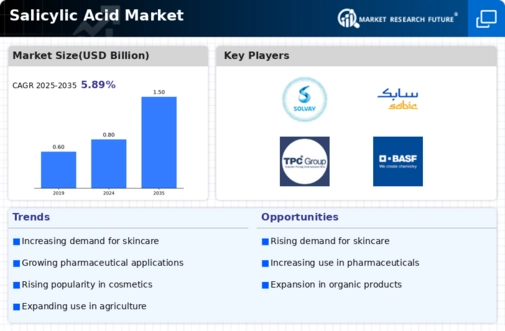Top Industry Leaders in the Salicylic Acid Market
 Salicylic acid, the unassuming hero behind clear skin and sparkling aspirin, isn't just a bathroom cabinet staple or a dull headache's demise. In this bustling arena, where giants clash and niches blossom, let's unmask the key players, their winning strategies, and the factors that determine who shines brightest.
Salicylic acid, the unassuming hero behind clear skin and sparkling aspirin, isn't just a bathroom cabinet staple or a dull headache's demise. In this bustling arena, where giants clash and niches blossom, let's unmask the key players, their winning strategies, and the factors that determine who shines brightest.
Key Players and Winning Strategies:
Global Chemical Titans: Companies like BASF SE (Germany), Bayer AG (Germany), Dow Chemical Company (US), and Lanxess AG (Germany) hold significant market share, wielding vast production capacities, diverse product portfolios, and established global footprints. Bayer, for instance, dominates the pharmaceutical segment with its high-purity salicylic acid for aspirin production.
Regional Champions: Players like Zhejiang Medicine Company Ltd. (China) and Sun Pharmaceutical Industries Ltd. (India) excel in specific regions, capitalizing on local manufacturing advantages and understanding regional needs. Sun Pharma caters to the cost-conscious Indian market with its efficient salicylic acid production.
Sustainability Champions: Emerging players like Evonik Industries AG (Germany) and BioAmber Inc. (US) are carving a niche through eco-friendly offerings. Evonik focuses on developing bio-based salicylic acid alternatives, aligning with the growing demand for sustainable solutions.
Niche Specialists: Smaller players like Salicylates America Inc. (US) and Salicylates India Pvt. Ltd. (India) push boundaries with specialized applications. Salicylates America caters to the food and beverage industry with its food-grade salicylic acid, while Salicylates India focuses on novel ester derivatives of salicylic acid for diverse uses.
Factors Shaping Market Share:
-
Purity and Versatility: Meeting diverse industry needs with varying purity levels, from pharmaceutical-grade to cosmetic-grade, and offering adaptability for various applications is crucial. Bayer's high-purity salicylic acid exemplifies this focus.
-
Cost-Effectiveness and Value Proposition: Balancing high quality with competitive pricing is vital, particularly in price-sensitive segments like over-the-counter medications. Sun Pharma's cost-effective salicylic acid finds favor in budget-conscious markets.
-
Sustainability and Environmental Footprint: Reducing carbon footprint, minimizing harmful chemical usage, and utilizing renewable feedstocks are becoming essential criteria for market penetration, driven by stricter regulations and eco-conscious consumers. Evonik's bio-based salicylic acid resonates with this trend.
-
Technological Advancements and New Applications: Constant research and development into new salicylic acid derivatives, applications in novel areas like bioplastics or plant growth regulators, and innovative delivery systems open up new avenues for market growth. Salicylates America's food-grade salicylic acid for food preservation illustrates this trend.
Key Companies
- Alfa Aesar
- Alta Laboratories
- JM Loveridge Limited
- Novocap
- Siddharth Carbochem Products Ltd.
- Simco Chemicals
- Hebei Jingye Group
- Loveridge
Recent Developments
-
July 2023: Dow Chemical partners with a leading skincare brand to develop a novel delivery system for salicylic acid in acne treatments, offering improved efficacy and reduced side effects.
-
August 2023: Lanxess successfully commercializes its bio-based salicylic acid production process, aiming to disrupt the market with its eco-friendly alternative.
-
September 2023: Zhejiang Medicine introduces a new range of salicylic acid derivatives for use in plant growth regulators, offering potential for improved crop yields and pest control.
-
October 2023: Salicylates America develops a food-grade salicylic acid-based coating for fruits and vegetables, extending shelf life and reducing food waste.
-
November 2023: Bayer collaborates with a research institute to develop salicylic acid-based biofuel from biomass, exploring its potential as a renewable energy source.
-
December 2023: The Cosmetic Ingredient Review (CIR) releases a safety assessment report on salicylic acid, reaffirming its safety for use in cosmetic products but highlighting the need for responsible and controlled usage.

